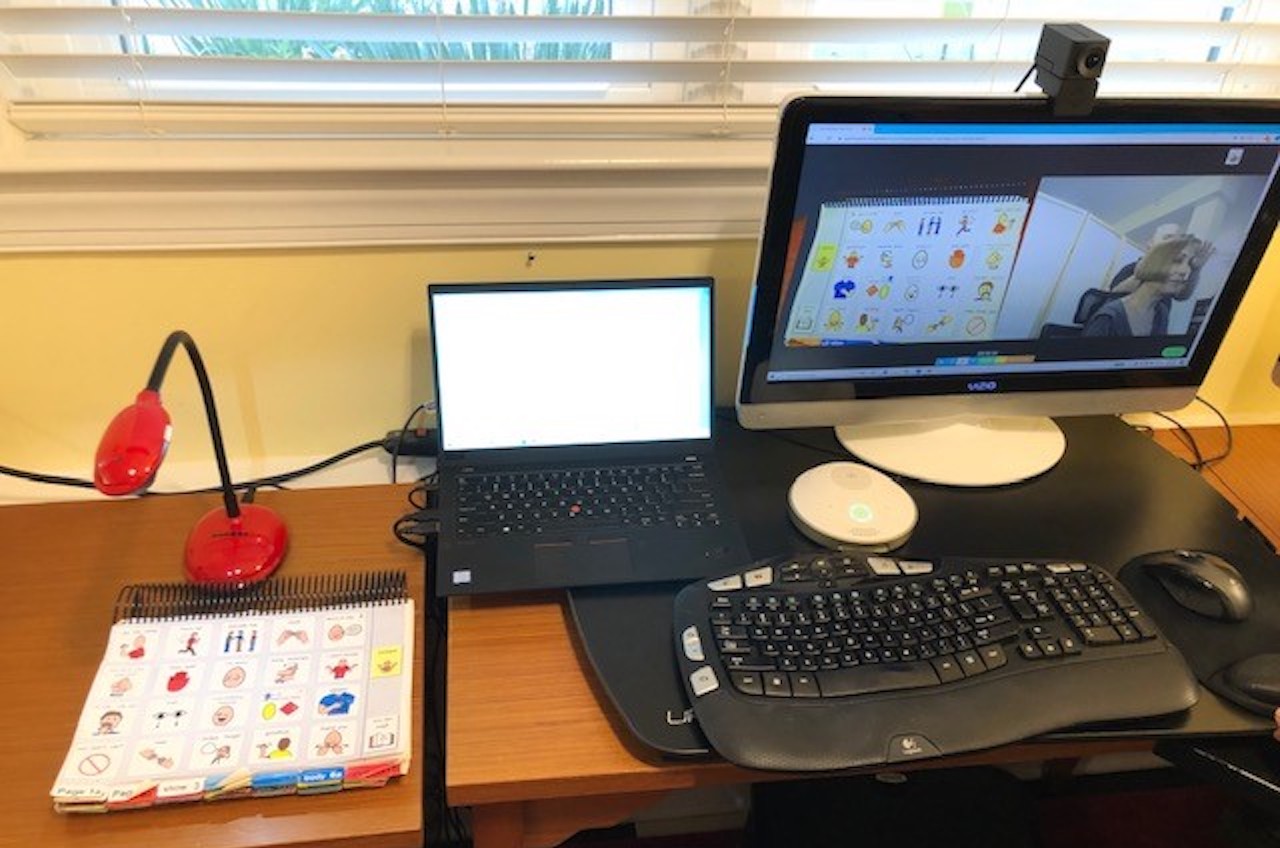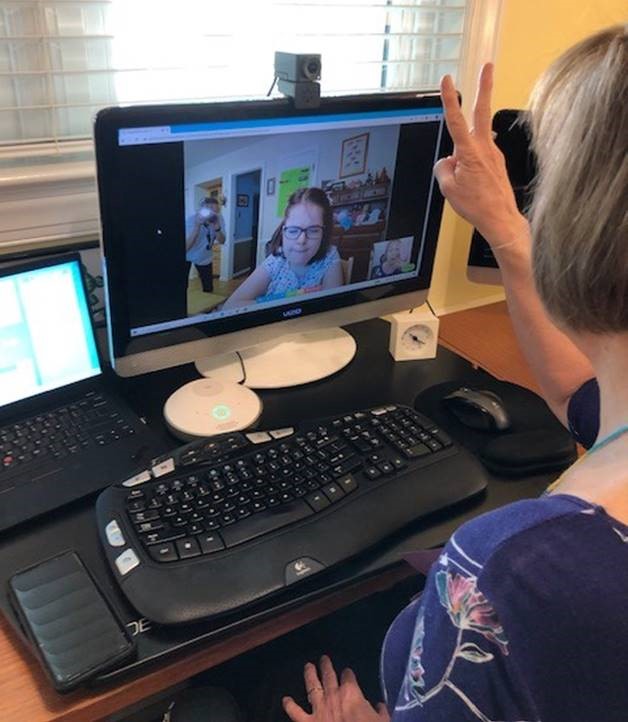Therapists Connect Remotely With the Help of Pro AV Tech

For many families, therapy has a resounding impact on their daily lives. In the wake of CDC recommendations regarding the coronavirus, however, therapy providers—including speech pathologists and occupational, physical, and behavioral therapists—are only seeing clients with urgent and emergency needs. This leaves a large gap for clients who still count on routine services. Rather than locking up the clinic and going dark, many are choosing to continue remotely by opening a telepractice. But there’s no playbook for how to take a service that traditionally relies on face-to-face interaction and move it online. For one speech pathologist in North Carolina, her response was to mobilize in the best way she knew how: with research.
“There was a lot to think about not only from the perspective of how and where to get started but also what technology was up to HIPPA and professional standards,” said Lynn Carswell, a speech language pathologist and owner of Right Fit Speech and Feeding Therapy. “I watched endless webinars and read whatever research I could get my hands on. It was a crash course with a ton of information to learn. In some ways I felt like I was going back to grad school all over again and doing it in a matter of a couple weeks.”
Related: Zoom Certifies Yamaha UC CS-700 Video Sound Bar
The first order of business was finding a videoconferencing platform that would allow her to work with her clients remotely. While many educators and enterprise employees are flocking to Zoom, Google Hangouts, Skype, and other solutions for simple team conferencing and collaboration, speech pathology and other therapy services often need more robust features and added security. Carswell selected TheraPlatform because it is a turnkey, HIPAA-compliant platform with end-to-end encryption conducive to providing speech therapy and protecting privacy.
However, settling on the platform was only one part of the equation. A much tougher hurdle was finding the audio and video components that would enable her to connect with clients as well as help improve client communication. For this, Carswell had to think about the experience from her client’s point of view—or more exact, from their screen.
“It's incredibly important for clients to be able to hear the verbal models I provide. This morning I was working with a four-year-old who substitutes the S sound with the T sound,” Carswell said. “In order for her to hear the really fine differences between those requires a high-quality microphone capable of picking up those distinctions. She also has to be able to see an up-close model of the mouth movements.”

A PC microphone and camera isn’t cut out for that level of quality. One microphone solution that’s popular is a headset, but Carswell felt it might distract the children with whom she works and possibly obscure mouth movements for those with hearing and vision impairments.
A daily selection of features, industry news, and analysis for AV/IT professionals. Sign up below.
As daunting as it seemed to find the AV equipment with the right fit for her needs, Carswell had someone in her corner well-versed in high-quality AV. Her husband, Greg, works for Yamaha Unified Communications (UC), a division of parent brand Yamaha. Yamaha’s core strength is in providing unrivaled music and sound technology. That technology is also interwoven in its lineup of conferencing equipment, which enable conversations that sound just as good as in person.
In 2018, Yamaha released its first portable speakerphone, the YVC-200, which allows users to carry on professional meetings anywhere without a loss in audio quality. Yamaha recently expanded the series with models featuring a new technology from Yamaha called SoundCap, which effectively cuts out noises such as kids talking or dogs barking in the background while intelligently focusing on the voices in its proximity. In Carswell’s case, the YVC-200 speakerphone was exactly what she needed to recreate the experience of an in-person session in the virtual world.
Greg was also able to steer her toward a web camera. In 2019, Yamaha partnered with camera manufacturer Huddly. The Huddly camera was particularly suited for Carswell’s telepractice because it allowed her to control the camera view. She can zoom in to provide clients with a verbal model in sharp detail.
The only remaining equipment needed was a document camera, which would allow her to share her Pragmatic Organization Dynamic Display (PODD) communication books. The PODD is a tool speech pathologists use to support communication for people with complex communication needs. However, with the increase in demand due to schools moving to e-learning plants, it was difficult to find an available document camera. A lot of practitioners were relying on hacks using their smartphones stacked on soup cans. In a turn of events, Smiley’s Audio Visual in central Florida heard Carswell’s story and donated a Lumens Ladibug from its inventory.
In less than a week, Carswell was up and running with a complete AV outfit with the quality that made her comfortable moving forward in an online capacity. She saw two clients before North Carolina issued its stay at home orders in March.
“I had to move so quickly to offer my clients continuity in their therapy, but I had no idea what the reaction was going to be,” Carswell said. “As it turns out, a lot of my clients were thrilled and responded right away. It was moving to know what this connection means for them. The kids are so excited because they're missing familiar faces at school and their daily routines.”
While no one could have predicted how quickly COVID-19 would reshape life, Carswell was thankful she had the support not only from clients and her colleagues within ASHA (American Speech Language Hearing Association) but also the professional AV industry so she could mobilize to the telepractice model. Currently, she’s seeing more than 50 percent of her clients and in some cases, the sessions are more frequent and longer than she was able to offer before because travel is no longer an issue and client’s schedules are much more open. In fact, with her new telepractice, Carswell says she has a professional AV solution that will allow her to sustain a teleservice option into the future rather than just the interim.
“There’s a lot of value with being able to reach people I previously wasn’t able to, whether due to distance or in some cases being medically at risk during cold and flu season,” Carswell said. “With the right equipment, it makes a really big difference in terms of quality of services you can provide to clients and it aligns to what they expect.”
The AVNetwork staff are storytellers focused on the professional audiovisual and technology industry. Their mission is to keep readers up-to-date on the latest AV/IT industry and product news, emerging trends, and inspiring installations.
